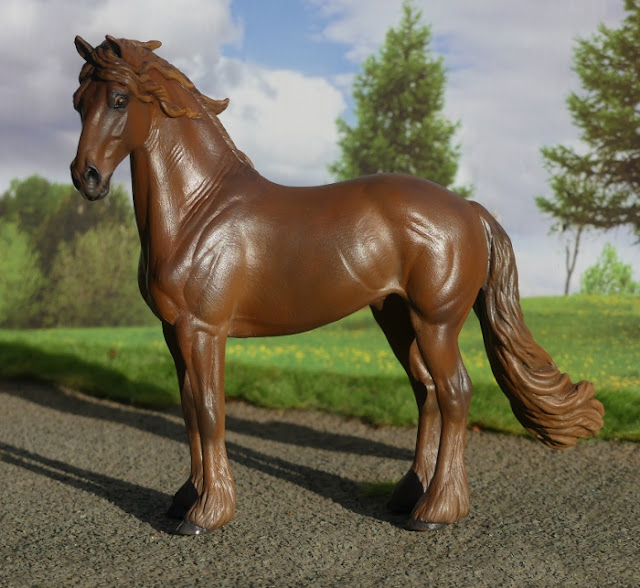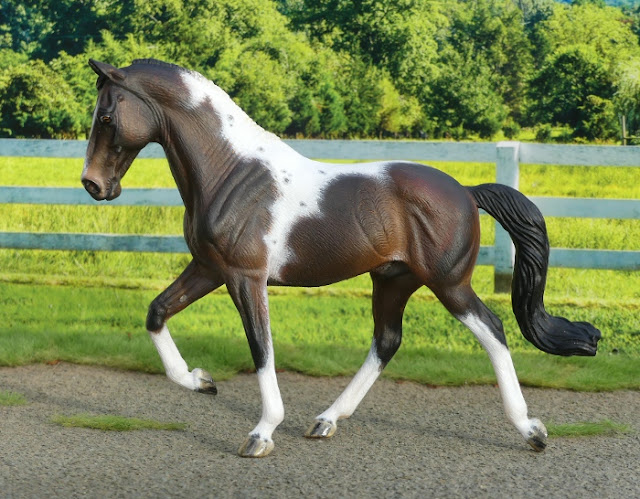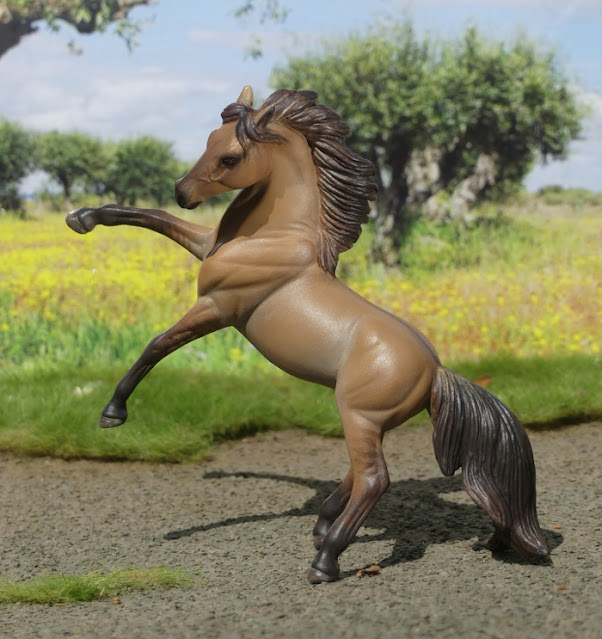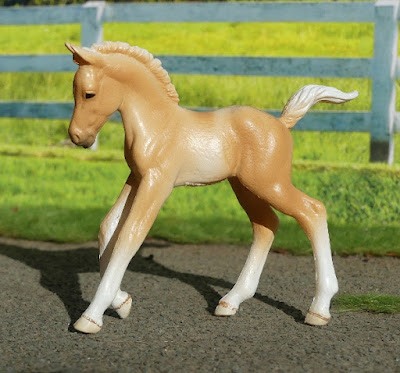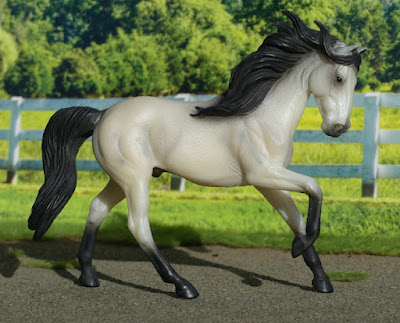As I said in my earlier blog post,
here, I recently ended up with a big box of second hand CollectA models, the cost of each duplicate to repaint being entirely absorbed by the total value of the models I'm keeping as they are - effectively these are free 'bodies' for my customising hobby!
Here's the first few breeds I've given their new lease of life as unique custom repaints...
The lovely little Campolina sculpt, it's so nice to have a rare breed so well-represented, and this handsome horse is the third of his breed to join my herd, after the original finish red dun, and my grulla repaint. This time I went for a different shade, a bay dun, with heavy primitive markings just like some of the best-know reference pics of this Brazilian breed. I'm really happy with how he turned out, I always find the paler colours more difficult to get looking really good, but I think the amount of darker detailing on this one stops him from being too washed-out and bland. I've named him Caldeirão, which taken literally means 'cauldron' but actually refers to a volcano's crater!
A second Brazilian breed (I didn't do this on purpose! Laughing), and it's the Mangalarga Marchador now in chestnut. In fact, I've named this one Castanhiero, which means 'chestnut'!
I copied his deep shade somewhere between red and liver from the reference photo in one of my horse breed books, his high white socks and quirky face marking are inspired by that one too - not a direct portrait, but I really liked the way the rich colour combined with so much white detail.
The Shetland pony is also a sort of semi-portrait idea - my own Shetland's father was written down as cremello on his pedigree, and though I've never managed to find any photos of him online, I decided to paint one of my CollectA ponies to match roughly like he would have looked. She doesn't have any white socks, and just a tiny few-hairs white marking on her forehead, so I went with the same for this mini model of her sire. His name is Snap Dragon, after the real pony I never met.

Another notoriously cute pony breed, the Chincoteague, a hardy native island pony with a tough nature and a sweet face! Though they do come in solid colours too, pinto is common - and the best-known pattern for the breed, after the much-loved Misty of Chincoteague came to fame. I decided to go for a buckskin pinto, just cos it's one of the colours I paint least often - again, I often struggle with giving the light yellowy brown enough depth, and getting the contrasting dark paints applied evenly enough to not look messy. This time I bypassed a lot of that trouble by having the legs be white rather than black!
One of my favourite CollectA moulds for her simple expressive calm - the twitched back ear, the passive face, the steady still pose. The Don was famously the horse of the Cossacks, and a huge influence on a lot of breeds from Central Asia into Eastern Europe. While chestnut might not be too far from the original finish paintwork of this model, I really wanted to have a go at my own version of this typical colour for the breed. Mine's turned out a lot more muted, tending toward brownish rather than orange, and I've gone a bit lightly with the metallic sheen - it's there, but I didn't want the gold to overwhelm the paint itself!
Next, the Nonius sculpt repainted as a Kabardin, an ancient breed from the Caucasus. Why the change? All Nonius horses are black, and I already had the black original finish model, and it's not a colour I could really add much variation to - not like my new chestnut Don being different enough to my other chestnut Don!
So I got out my breed books and hunted through for one which made the best match to CollectA's Nonius mould, with his sloping hindquarters, slim shoulders, and lonnng convex profile - and this was it! The example in the photos had a particularly nice pale nose, too, which settled it - I do love a mealy muzzle on a very dark bay!
Much like with the Nonius-to-Kabardin, I picked the CollectA Friesian from the box of duplicates to repaint, and thought 'now what am I going to do with you?'. My existing one in original finish is already a well-painted black, with some nice warm tones in his paint and a sleek semi-glossy finish, so if I painted a black custom it wouldn't really be that much different to the one I already had, only in the eyes and feet would I be able to show any more detail. And the breed is almost entirely black.
So, any other breeds it looks like? Not with that body type and that much feathering, combined with the typical upright pose - it's pretty much only Friesians which have the exact same outline as Friesians!
Then I had an idea which solved this dilemma - the breed is almost entirely black, but not 100%. Purebred chestnuts exist! Sadly they're deeply unpopular in the show ring, and chestnut stallions can't be approved as breeding studs. The vast majority of breeders from the post-war period onwards have been trying to eliminate them in preference for all black, and these days they're all DNA tested - any stallion which even carries the red gene (despite being black!) cannot be registered with the international breed society either.
We may well end up losing the red gene from all continuing stallion lines in future - except in the USA, where a second spin-off unaffiliated breed association allows chestnuts. So I've painted a specifically American chestnut Friesian, to create a little model character who can be appreciated for what he is, and not treated like a rule-break or a mistake!
I think the mould looks great in a different colour to usual, the lighter paint brings out a lot of the sculpting detail which is hidden in a plain black. CollectAs always have such beautifully expressive faces, too!
He looks like he's a bit of a lively one, on full alert and ready to spring into action!
I still have one more duplicate Friesian to paint, so I'm going to have to think even harder to come up with another colour, or a different breed he could switch to be instead! May have to go partbred in the end...
Here's another pony who changed breeds significantly! To me, the Haflinger sculpt never really looked like the breed she was designed as, too light in the body, too long and lean in the leg - more like a lightweight riding pony cross, than the mini-draft build of the true Haflingers which are like big chunky barrels of blonde pony Laughing But the head is too large and long for a really refined show pony type, so I spent ages sifting through all my various horse books to try to find something which has both the small elegant build, and the larger head.
Eventually settled on Indonesia, and the similar Java and Sandalwood ponies, which seemed ato be the closest match - they look small and pretty, with the heavy head being noted as a negative 'flaw' in the text description. The Sandalwood seems to be a little bit finer in the leg, a couple of books mention imported Arabians and small Thoroughbreds being used in the colonial era to refine them and make them more a riding-pony type, than a practical tough working animal - the Java is still truer to old type.
One of the Sandalwood pony photos showed a very-speckled fleabitten grey, and I decided that was the one I'd copy for my first repaint of this breed - I actually found the exact same photo online, though it's very tiny :
here
And here's my model version! Not a colour I've painted very often, even though my first real-life horse was a speckly grey, it's very fiddly at this scale where using the toothbrush-paint-spatter technique wouldn't look quite so good as it does at Stablemate scale - on a horse this big, the specks look better if they're slightly elongated to follow the direction of the hair. I used a combination of two methods this time, firstly a lot of little paint strokes applied with a tiny brush, then over the top of that I added more detail (and more darkness to the most heavily speckled areas) with a normal writing pencil. I think it's quite effective, she looks as speckly as the reference picture!
Another angle, which doesn't flatter the proportions of head to body in the slightest, but shows her face well! I do have one other Haflinger body, not from this boxful but from an earlier purchase of play-worn models which needed a new lease of life, so I think she'll be getting a friend of the same breed at some point soon - they come in plenty of colours!
Next up in this batch, and yet again, this was the result of flipping through several different breed books to pick a best-match to a model I didn't really want to repaint as it's original all-one-colour breed! This time was the American Cream Draft, a sculpt with a hefty neck, long back, chunky leg, and not a lot of feather, so I looked through the pages til one jumped out as a good likeness - the Muraközi. A draft breed from Hungary, they're mostly black and grey but the example in one of my books was such a stunning dappled chestnut that I knew that was the colour I wanted to paint!
Here he is, I'm really pleased with how he turned out - the dappling was a bit nerve-wracking to paint cos there's always the feeling that I'm potentially ruining a paintjob which was working out fine and would've been best left well alone without the dapples, but they were worth the scary stage cos they look nice in the end!
It's always satisfying to make a brand new breed page on my website and expand my collection's range, but I think researching and painting them myself is even more fun than just buying one! I've named him Király, which means King.
And here he is with his book self, so you can see the beautiful photo which inspired my breed choice!
The Tennessee Walking Horse is one of my favourite CollectA moulds, showing the breed's very interesting gait in a natural flat-shod style, without the artificial wedged and weighted shoes and long-toed trimming which were the showring standard for many decades. It's nice to see model companies deciding not to favour the exaggerated Big Lick style any more.
I painted a bay sabino once before, so this time I decided to go for a different white pattern, and make him a seal brown tobiano pinto - love how he turned out! His name is Diamond Dreamer.
A second Haflinger, became a second Sandalwood pony! While looking up the breed for painting my first one, I was struck by the huge variety of colours they come in - dun in all its forms seemed to be fairly common, as do flashy white markings. This one wasn't copied from any one pony, just me combining the coat colour from one with the idea of long white stockings from another.
And the last, for now - the Hackney has had a makeover from chestnut to...chestnut!
I always found the mould far, far too chunky to be a decent representation of a very fine-boned delicate and elegant breed, so one more time I flicked through my little collection of horse breed books, on the hunt for a tall carriage horse of a more warmblood-type. The Gelderland seemed the best match of all for the model I had in hand, so that's what I went with. Most of the example photos showed vivid bright gingery or red chestnuts, all with extensive white markings on the legs, and the faces too.
There's many many more to come, I wonder what breeds I'll be painting next year...










